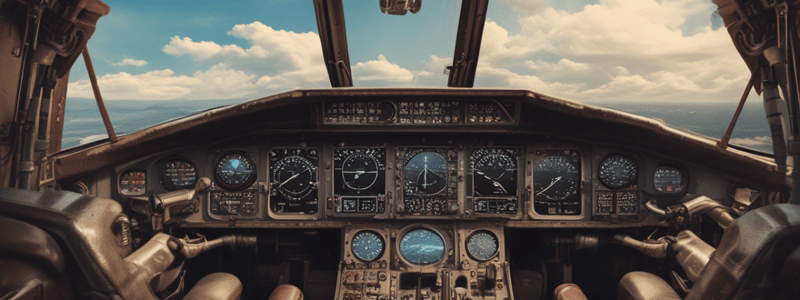Podcast
Questions and Answers
What does the altimeter typically display?
What does the altimeter typically display?
- Aircraft's heading and course information
- Aircraft's climb or descent rate
- Aircraft's airspeed
- Aircraft's altitude above mean sea level (MSL) (correct)
What is the primary function of the Vertical Speed Indicator (VSI)?
What is the primary function of the Vertical Speed Indicator (VSI)?
- To indicate the aircraft's heading and course information
- To indicate the aircraft's altitude
- To indicate the aircraft's airspeed
- To indicate the aircraft's climb or descent rate (correct)
What is typically displayed on a Horizontal Situation Indicator (HSI)?
What is typically displayed on a Horizontal Situation Indicator (HSI)?
- Aircraft's heading and course information (correct)
- Aircraft's airspeed
- Aircraft's altitude above MSL
- Aircraft's engine performance parameters
What is the primary function of the Multi-Function Displays (MFDs)?
What is the primary function of the Multi-Function Displays (MFDs)?
What is the primary function of the Moving Map Display on an MFD?
What is the primary function of the Moving Map Display on an MFD?
What is the primary function of the Terrain Awareness and Warning System (TAWS)?
What is the primary function of the Terrain Awareness and Warning System (TAWS)?
What is the primary function of the Weather Radar on an MFD?
What is the primary function of the Weather Radar on an MFD?
What information is typically displayed on an Engine Instrumentation system on an MFD?
What information is typically displayed on an Engine Instrumentation system on an MFD?
What is the primary function of the Traffic Information system on an MFD?
What is the primary function of the Traffic Information system on an MFD?
What is the result of the integration of PFDs and MFDs within the cockpit?
What is the result of the integration of PFDs and MFDs within the cockpit?
The primary purpose of the Attitude Indicator is to display the aircraft's airspeed.
The primary purpose of the Attitude Indicator is to display the aircraft's airspeed.
The layout of the Primary Flight Display is designed to resemble traditional analog instruments.
The layout of the Primary Flight Display is designed to resemble traditional analog instruments.
The Airspeed Tape on a PFD displays the aircraft's altitude.
The Airspeed Tape on a PFD displays the aircraft's altitude.
Multi-Function Displays are used for navigation only.
Multi-Function Displays are used for navigation only.
The symbiotic relationship between the craft's attitude and flight path is irrelevant to pilots.
The symbiotic relationship between the craft's attitude and flight path is irrelevant to pilots.
PFDs and MFDs are only used in older aircraft.
PFDs and MFDs are only used in older aircraft.
The primary function of PFDs is to provide pilots with weather information.
The primary function of PFDs is to provide pilots with weather information.
PFDs and MFDs are not critical to flight operations.
PFDs and MFDs are not critical to flight operations.
The Attitude Indicator is only used in emergency situations.
The Attitude Indicator is only used in emergency situations.
MFDs are used to display traditional flight instruments.
MFDs are used to display traditional flight instruments.
What is the primary benefit of a PFD displaying altitude above mean sea level?
What is the primary benefit of a PFD displaying altitude above mean sea level?
How do pilots typically use the VSI during flight?
How do pilots typically use the VSI during flight?
What is the primary advantage of integrating navigation course information with heading information on a PFD?
What is the primary advantage of integrating navigation course information with heading information on a PFD?
How do MFDs enhance a pilot's situational awareness during flight?
How do MFDs enhance a pilot's situational awareness during flight?
What is the primary benefit of a TAWS on an MFD?
What is the primary benefit of a TAWS on an MFD?
How do pilots use the weather radar feature on an MFD?
How do pilots use the weather radar feature on an MFD?
What is the primary advantage of integrating traffic information with TCAS on an MFD?
What is the primary advantage of integrating traffic information with TCAS on an MFD?
How do pilots use engine instrumentation on an MFD?
How do pilots use engine instrumentation on an MFD?
What is the primary benefit of the symbiotic relationship between the aircraft's attitude and flight path on a PFD?
What is the primary benefit of the symbiotic relationship between the aircraft's attitude and flight path on a PFD?
What is the primary impact of the integration of PFDs and MFDs on flight operations?
What is the primary impact of the integration of PFDs and MFDs on flight operations?
Flashcards are hidden until you start studying
Study Notes
Primary Flight Displays (PFDs)
- PFDs are essential in presenting critical flight data in a clear and intuitive manner.
- They have replaced analog dials, enabling pilots to grasp complex information at a glance.
- A typical PFD consists of:
- Artificial horizon (pitch and roll)
- Airspeed indicator (digital marvel providing precise airspeed readings)
- Altimeter (altitude readout relative to sea level)
- Vertical speed indicator (rate of ascent or descent)
- Heading display (guides pilots like a compass with advanced precision)
- Attitude Director Indicator (ADI) (dictates positioning and prompts pilots towards navigational perfection)
Importance of PFDs
- Calibration and alignment of PFDs are crucial to ensure accurate readings.
- Uncalibrated PFDs can lead to misleading information, putting flight safety at risk.
- PFDs enhance situational awareness, ensuring the dependability of flight and embodying the essence of modern aviation.
Multi-Function Displays (MFDs)
- MFDs are the central hub of cockpit data, representing the evolution of aviation instrumentation.
- They provide a plethora of information at a glance, including:
- Navigational maps
- Weather radar
- Traffic information
- Detailed systems data
- MFDs reduce clutter and streamline pilot workload, prioritizing critical information through interactive menu systems.
- Interactivity is a key feature, with tactile buttons or touchscreens acting as the interface.
Key Features of MFDs
- Moving map display (provides a graphical representation of the aircraft's position and planned route)
- Terrain awareness and warning system (TAWS) (offers a color-coded map indicating terrain elevations and potential collision hazards)
- Weather radar (displays weather patterns and intensities)
- Traffic information (integrates with traffic collision avoidance systems (TCAS) to show the position of nearby aircraft)
- Engine instrumentation (allows monitoring of engine performance parameters)
Integration of PFDs and MFDs
- The integration of PFDs and MFDs within the cockpit has revolutionized how pilots interact with their aircraft.
- They provide pilots with essential information for safe and efficient flight operations.
Electronic Flight Displays and Advanced Navigation
- Introduction to Electronic Flight Displays and Advanced Navigation, focusing on Primary Flight Displays (PFDs) and Multi-Function Displays (MFDs)
- Understanding the functionality of PFDs and MFDs is crucial for pilots to grasp complex information at a glance
Primary Flight Displays (PFDs)
- PFDs consolidate traditional flight instruments into an integrated display format
- Typical PFD elements include:
- Artificial horizon: displays the aircraft's pitch and roll
- Airspeed indicator: provides precise airspeed readings
- Altimeter: displays altitude relative to sea level
- Vertical speed indicator: shows the rate of ascent or descent
- Heading display: guides pilots with advanced precision
Importance of PFDs
- PFDs orchestrate flight management with eloquence and efficacy
- Ensuring accurate calibration and alignment is crucial for safe flight operations
Multi-Function Displays (MFDs)
- MFDs are the central hub of cockpit data, providing a plethora of information at a glance
- Typical MFD elements include:
- Navigational map
- Weather radar
- Traffic information
- Detailed systems data
- MFDs reduce clutter, streamline pilot workload, and enhance situational awareness
Benefits of MFDs
- MFDs provide a unified view of flight information, allowing pilots to make informed decisions quickly
- Interactivity is a key feature, with tactile buttons or touchscreens acting as the interface
- Customization is possible, allowing pilots to tailor the displayed information to suit their needs
Navigation and Flight Planning
- MFDs can merge chart data, aircraft position, planned route, and airspace information to provide an unparalleled view of flight plans
- Integration with other avionic systems like GPS and ADS-B enhances MFD functionality
Managing MFD Information
- Pilots should be familiar with efficient ways to switch between displays and prioritize critical information
- Best practices for managing information are essential for safe flight operations
Primary Flight Displays (PFDs)
- PFDs are essential in presenting critical flight data in a clear and intuitive manner
- They have replaced a plethora of analog dials, enabling pilots to grasp complex information at a glance
- A typical PFD consists of:
- Artificial horizon: displays the aircraft's pitch and roll
- Airspeed indicator: provides precise airspeed readings
- Altimeter: displays the aircraft's altitude above mean sea level (MSL)
- Vertical speed indicator: indicates climb or descent rate
- Heading display: guides pilots like a compass with advanced precision
- Attitude Director Indicator (ADI): dictates positioning and prompts pilots towards navigational perfection
Importance of Calibration and Alignment
- Ensuring the PFD is accurately reading is crucial for flight safety
- Uncalibrated PFD can lead to misleading information, putting the safety of the flight on the line
Multi-Function Displays (MFDs)
- MFDs are the central hub of cockpit data, representing the evolution of aviation instrumentation
- They provide a plethora of information at a glance, including:
- Navigational maps
- Weather radar
- Traffic information
- Detailed systems data
- MFDs reduce clutter and streamline pilot workload substantially
- Interactivity is a key feature, with tactile buttons or touchscreens acting as the interface
Key Features of MFDs
- Moving map display: provides a graphical representation of the aircraft's position and planned route
- Terrain awareness and warning system (TAWS): offers a color-coded map indicating terrain elevations and potential collision hazards
- Weather radar: displays weather patterns and intensities
- Traffic information: integrates with traffic collision avoidance systems (TCAS) to show the position of nearby aircraft
- Engine instrumentation: allows monitoring of engine performance parameters such as fuel flow, oil pressure, and engine temperatures
Benefits of MFDs
- Enhance situational awareness tenfold
- Allow pilots to make informed decisions quickly, especially under pressure
- Provide customization options to suit the phase of flight or personal preference
- Integrates with other avionic systems like GPS and ADS-B to enhance their functionality
Studying That Suits You
Use AI to generate personalized quizzes and flashcards to suit your learning preferences.



